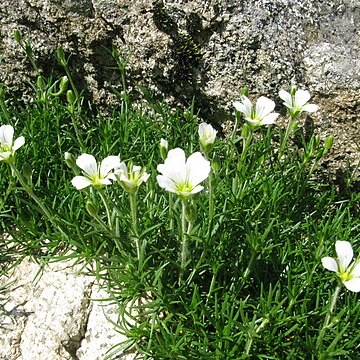Plants perennial, mat-forming. Taproots stout, woody. Stems erect to ascending, green, 3-10 cm, retrorsely puberulent or stipitate-glandular, internodes of flowering stems 2-6 times as long as leaves. Leaves tightly overlapping (vegetative) or variably spaced (cauline), usually connate proximally, with tight, scarious to herbaceous sheath 1.2-1.5 mm; blade straight to outwardly curved, green, obscurely 1-veined, linear (proximal vegetative) or subulate (cauline), rounded 3-angled (abaxial surface thickened, rounded, adaxial surface flat to concave), 5-20 × 0.4-1 mm, flexuous, margins not thickened, herbaceous, often ciliate, apex often purple, rounded to truncate, shiny, glabrous (vegetative) or glabrous to stipitate-glandular (cauline); axillary leaves absent. Inflorescences: flowers solitary, terminal; bracts narrowly lanceolate to oblong, herbaceous. Pedicels 0.5-3 cm, usually densely stipitate-glandular. Flowers: hypanthium cup-shaped; sepals prominently 3-veined proximally, lanceolate to narrowly ovate (herbaceous portion often purple, ovate to oblong), 4-8 mm, enlarging slightly in fruit, apex often purple, rounded, hooded, stipitate-glandular; petals oblanceolate, 1.5-2 times as long as sepals, apex broadly rounded, entire. Capsules narrowly ellipsoid, 9-10 mm, longer than sepals. Seeds brown, suborbiculate with radicle prolonged into beak, compressed, 1.2-1.6 mm, minutely tuberculate (50×). 2n = 22 (Russia), 26 (Russia), 38 (Russia), 52, ca. 80.
More
Herbs perennial, 5--9 cm tall. Stems densely caespitose, glandular pubescent. Leaves linear, 0.6--1.6 cm × ca. 1 mm, those on flowering stems smaller. Flowers solitary, rarely 2. Sepals linear-oblong, 5--7 mm, glandular pubescent. Petals ca. 2 × as long as sepals. Capsule 1.5--2 × as long as sepals. Seeds brownish, reniform-globose, 1--1.5 mm; raphe obtusely tuberculate. Fl. and fr. Jul--Aug.

